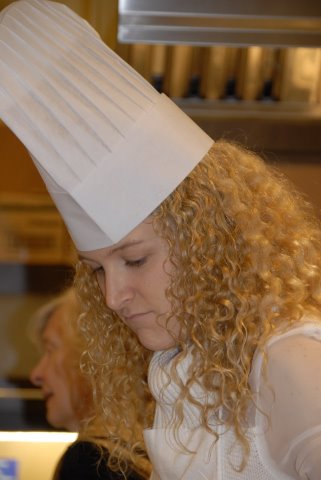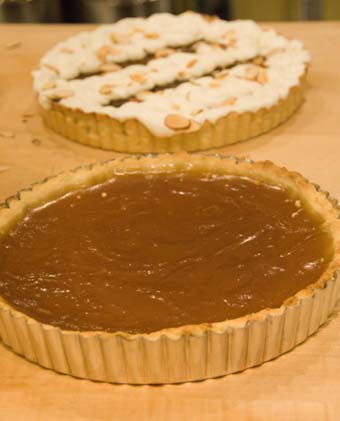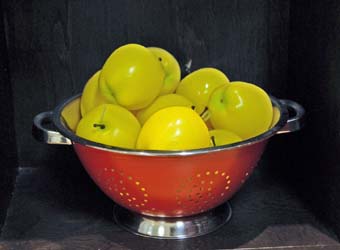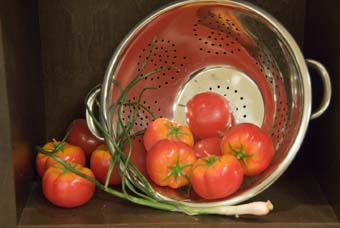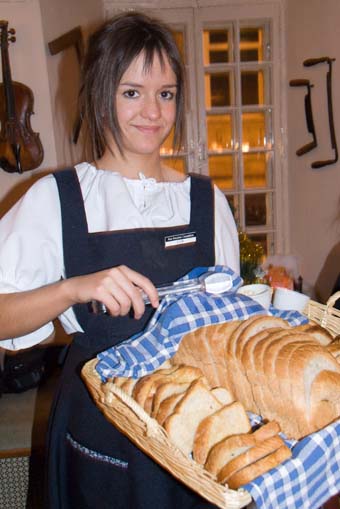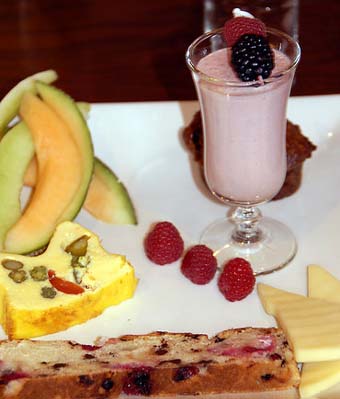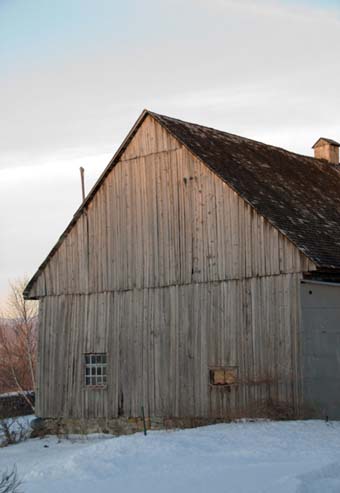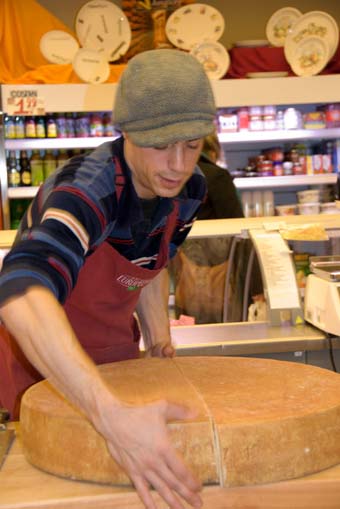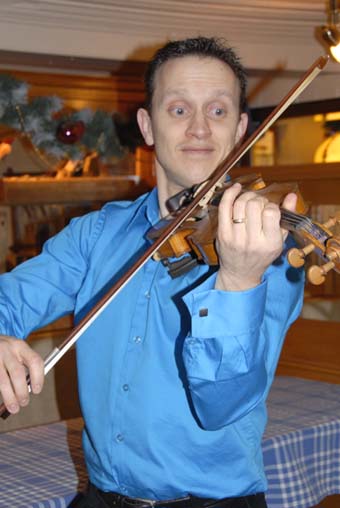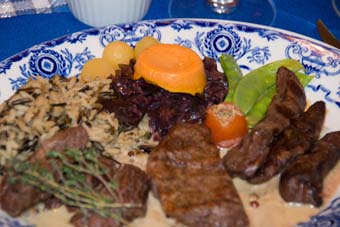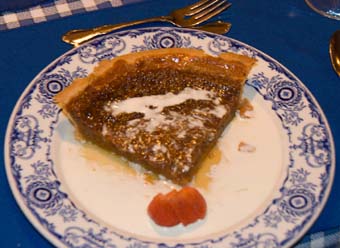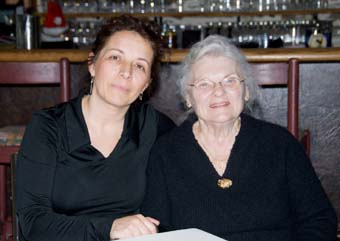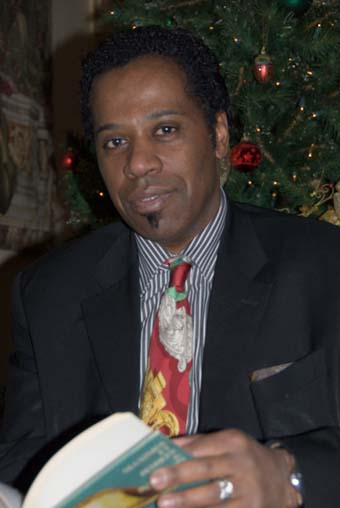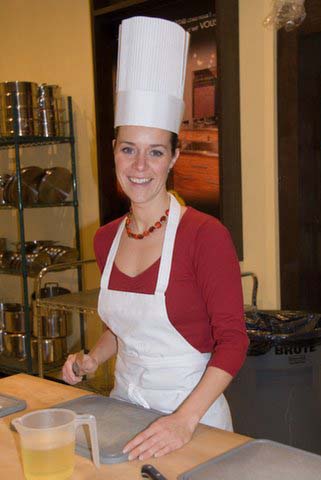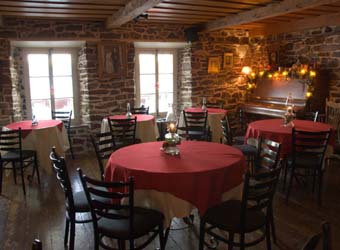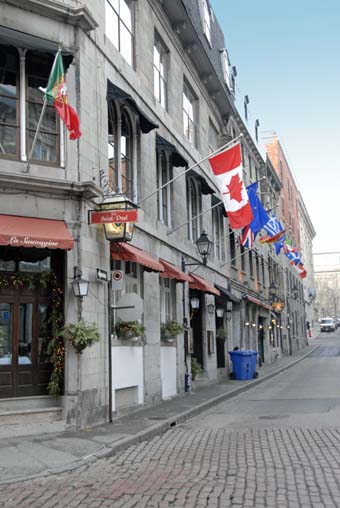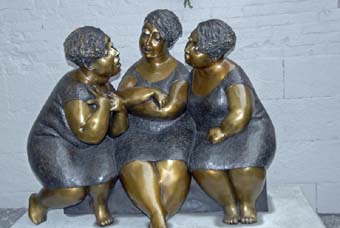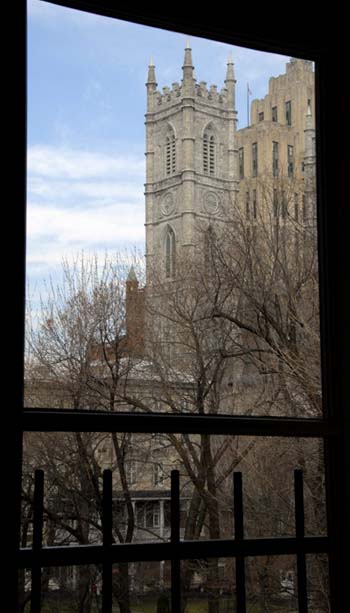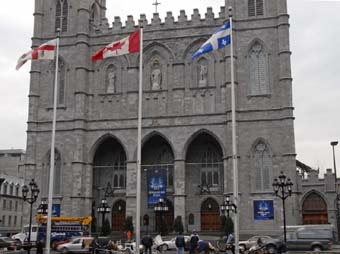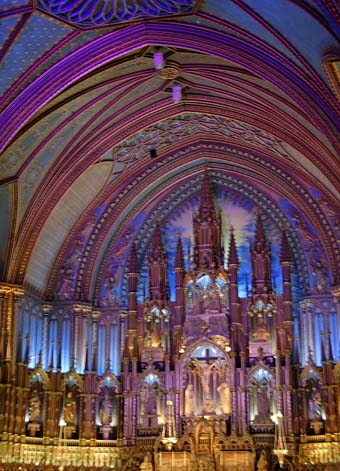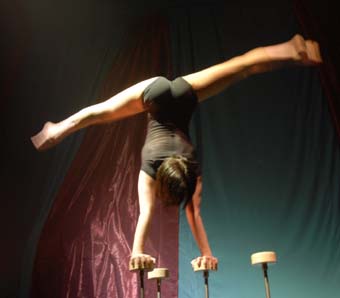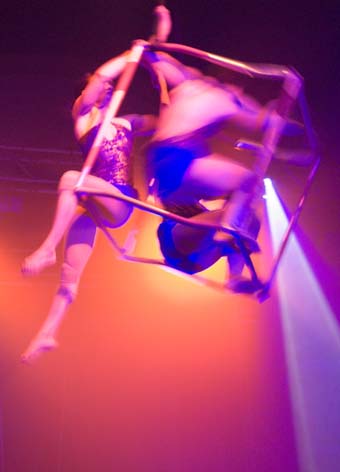In North America, we are most fortunate
to have the richness of French-Canadian culture and the tantalizing
uniqueness of Québec’s regional cuisine virtually at
our doorstep. No need to take a long and tiring flight across the
ocean in order to experience the novelty of a different culture
and its food culture traditions. Because of this, the Province of
Québec is an ideal choice for culinary tourism and is easily
accessible by plane, car, and train.
It’s no secret that French
Canadians have a passion for good food and a love of fine dining,
as well as casual grazing. Coupled with their appreciation for local
farmer’s markets, the importance of high quality fresh ingredients,
and respect and admiration for their chefs — it’s no
wonder that Quebec is a magnet for food lovers and chefs! Young
chefs who want to make their mark in the world of gourmet often
come to train and work in Québec City.
Whether visiting Montréal
or Québec City, a culinary journey of both cities is not
only affordable, but will delight the traveler with memorable food
experiences that tantalize the taste buds and speak to all five
human senses. From a circus dinner show, to a Québécois
cooking school, to a specialty seafood bistro, to the Old Québec
charm and gastronomy, the choices are abundant for those who want
to explore culture through food. Whether searching for cuisine
du terroir, cuisine bourgeoise, haute cuisine,
nouvelle cuisine, or multi-cultural and ethnic cuisines,
Québec is a destination of choice.
QUEBEC CITY
The Hôtel Château Laurier
Québec serves as a convenient home base while in Québec
City, as it is within walking distance of most major sites and only
a block away from Grande Allée, where many of the cities’
most popular and trendiest restaurants are located. Newly renovated,
it exudes Old World charm with modern conveniences.
Start your culinary Québécois
journey with a luncheon stop at L’Échaudé, a
classic bistro noted for its constant invention. This is hearty
bistro cooking in the Old Port section of town. I particularly enjoyed
the selection of cheeses as an appetizer.
Offering the colors and flavors of
Mediterranean cuisine, Largo Resto Club is a new restaurant in the
Nouveau St. Roch district that specializes in seafood and savory.
Sophisticated and voguish, the décor is casually comfortable
in an up-scale way.
For a complete dinner experience
and entertainment package rolled into one, don’t miss the
École de cirque de Québec, located in the old Saint-Esprit
church. With a dinner show menu of chicken liver mousse and confit,
stuffed pork ballottine with wild mushroom sauce, soup of the day,
and chef dessert, the meal is nothing short of extraordinary. Dinner
is followed by a glimpse of the world of circus arts: live aerial
trapeze performances, feats of flexibility, and unique comic interludes.
As the only circus arts school in Québec City, this not-for-profit
school promotes circus arts and fosters a new generation of performing
artists.
It is not surprising therefore to
learn that Québec, which spawned the enormously successful
and very contemporary Cirque
du Soleil, is a major global center for the circus arts.
For Old Québec charm and gastronomy,
a “must do” experience is the Restaurant Aux Anciens
Canadiens.
The restaurant is one of the oldest
buildings in Québec (built between 1675 and 1676) and is
also one of the finest examples of the Québécois mansardé
architecture for which Québec is so famous.
Internationally known for its fine
cuisine and warm hospitality, Aux Anciens Canadiens features authentic
Québécois specialties and game. The wait staff is
dressed in period costume and live music easily sets the mood of
le bon vieux temps of the French régime in North America.
During my visit, I was entertained
by virtuoso Patrice
Painchaud and his violin while I dined on grandmother’s
pea soup and les trois mignons: grilled tenderloin of stag,
caribou, and buffalo served with a cognac and pink pepper sauce.
In the country, just outside of Quebec
City, is the Restaurant Les Ancêtres. A 300-year-old family
home that is brimming with history, the setting offers views of
the Laurentians and Montmorency Falls. Les Ancêtres offers
fine regional dishes as well as traditional habitant cuisine
such as meatball stew with pig’s feet or pork roast with yellow
potatoes.
Would you like to try your hand at
stirring up some traditional recipes? Spend a morning at L’Académie
Culinaire de Québec in Sainte-Foy (a suburb of Québec
City) where you can make and bake tourtière (the
traditional Québécois meat pie that is on every table
at special festive times) and calorie-laden but oh-so-delicious
tarte au sucre (maple sugar pie). The best part is when
you eat the results of your labors.
MONTRÉAL
VIA Rail, Canada's passenger rail
services provides frequent and very comfortable connecting rail
service between Quebec City and Montréal. For my journey
to Montreal, I took the First Class VIA 1 train, with a full breakfast
served on board. Arriving three hours later, I headed for Old Montreal
to check-in to my hotel.
A 4-star rating, the Auberge Bonaparte
in Vieux Montréal (the artfully restored port area of Old
Montreal) is beautifully appointed with Louis-Philippe style furnishings
— smooth surfaces and grand silhouettes but with subtler sophistication
and understated elegance. I am warmly greeted by the affable and
charismatic owner, Michael Banks, whereupon I am escorted to a beautiful
room with an expansive view — of Montréal's well-known
Notre-Dame Basilica.
That evening, my first dinner choice
in Montreal was a seafood bistro offering every type of oyster known
to mankind — or so it seemed after reading prominent poster
menus that identify the global origins of different oysters. Maestro
SVP is a new market cuisine concept that is a “must do”
for any serious seafood lover. My Madagascar Scallops sautéed
with green peppercorns and flambéed with brandy was an indescribable
journey to culinary heaven.
Across the street from the Auberge
Bonaparte, is Casa de Matéo, an authentic Mexican restaurant
that has been the recipient of the Consumers Choice Award six times,
earning the Gold in 2003. They were chosen by The Montréal
Mirror newspaper as the best Mexican restaurant in Montréal,
and live up to their award-winning reputation with their excellent
service and food. I stopped here to grab some early appetizers before
my evening concert at Notre-Dame Basilica of Montréal —
the jewel in the crown of Old Montréal.
A masterpiece of Gothic Revival,
the Notre-Dame Basilica of Montréal has an equally dramatic
and colorful interior: a deep-blue ceiling with golden stars and
a kaleidoscope of cool colors ranging from blue, azure, red, and
purple to silver and gold.
After an evening concert at Notre-Dame
Basilica, I walked around the corner for a post-theater dinner at
my hotel in its Restaurant Bonaparte. Considered one of the top
100 restaurants in Canada, the Bonaparte sets the standard for classical
French cooking. With impeccable service, exquisite food sensations,
and artful plating, this is the place to celebrate that special
occasion, whatever it may be.
IF YOU GO:
The
Québec City area website
Montréal
tourism website
The
provincial tourism website
VIA
Rail Canada
WHERE TO EAT:
Largo Resto Club
643, rue Saint-Joseph Est
Québec (Québec) G1K 3C1
Tel.: (418) 529-3111
www.largorestoclub.com
L’Échaudé
73, rue Sault-au-Matelot, Vieux-Port
Québec (Québec) G1K 3Y9
Tel.: (418) 692-1299
www.echaude.com
Restaurant Aux Anciens Canadiens
34, rue Saint-Louis
Québec (Québec) G1R 4P3
Tel.: (418) 692-1627
www.auxancienscanadiens.qc.ca
École de Cirque de Québec
750, 2ième Avenue
Québec (Québec) G1L 3B7
Tel.: (418) 525-0101, ext. 236
www.ecoledecirque.com
Restaurant Les Ancêtres
391, chemin Royal
Saint-Pierre-de-I’lle-d’Orléans
(Québec) G0A 4E0
Tel.: (418) 828-2718
www.lesancetres.ca
Hôtel/Restaurant Bonaparte
447, rue Saint-François-Xavier
Montréal (Québec) H2Y 2Tl
Tel: (514) 844-1448
www.bonaparte.com
Maestro SVP
3615 Saint-Laurent Blvd.
Montréal (Québec)
Tel: (514) 842-6447
www.maestrosvp.com
Casa de Matéo
440, rue Saint-Francois-Xavier
Montreal (Québec) H2Y 2T3
www.casademateo.com
WHERE TO STAY:
Hôtel Château Laurier
Québec
1220, place George-V Ouest
Québec (Québec) G1R 5B8
Tel.: (418) 522-8108
Reservations: 1-800-463-4453
www.vieuxquebec.com/laurier
Hôtel Bonaparte
447, rue Saint-François-Xavier
Montréal (Québec) H2Y 2Tl
Tel: (514) 844-1448
www.bonaparte.com
WHERE TO LEARN THE CULINARY ARTS
OF QUÉBEC
L’Académie
Culinaire de Québec
2740, boulevard Laurier
Sainte-Foy QC G1V 4P7
Tel: (418) 780-2211
1-877-393-8111
The International Culinary
Tourism Association
The mission of ICTA (www.culinarytourism.org)
is to help food and beverage manufacturers and providers, as well
as travel industry professionals, package and promote their culinary
treasures as marketable and sellable attractions.
The ICTA accomplishes its mission
by facilitating partnerships between complementary organizations,
facilitating culinary tourism product development and marketing,
promoting culinary tourism education, conducting and publishing
culinary tourism research and promoting best practices in culinary
tourism management.
Patrice Painchaud: Québec
in Song
Québec expresses itself and
its culture in many ways, especially through music. The music industry
in Québec is one of the largest and most vibrant in the world.
Patrice is an example of the musical traditions of Québec.
(www.patricepainchaud.com)
Patrice is a multi-talented musician
and performer who is also a part of the Painchaud Quartet. Composed
of Patrice, his two brothers and a sister. Each of them plays a
number of musical instruments with a wide repertoire of music that
includes classical and folklore. They all entered the Music Conservatory
between the ages of 3-5, and all have been soloists with the Québec
Symphonic Orchestra.
 The preceding audio clip of New France music is compliments of Patrice.
The preceding audio clip of New France music is compliments of Patrice.
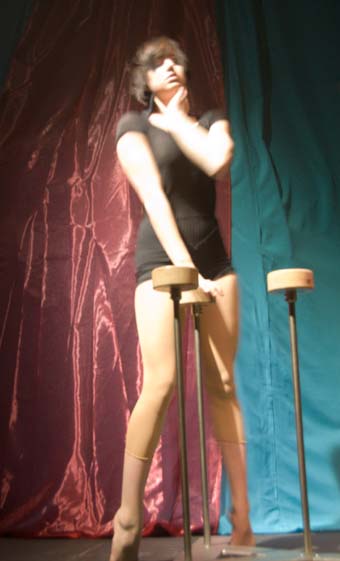

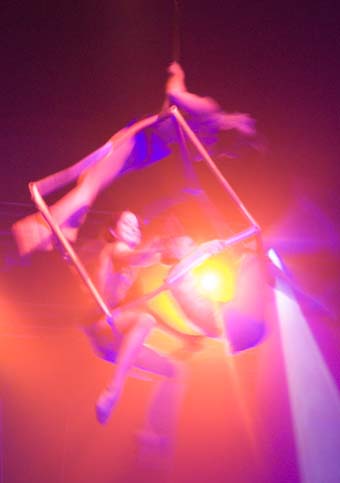
All photographs
by Karin Leperi
